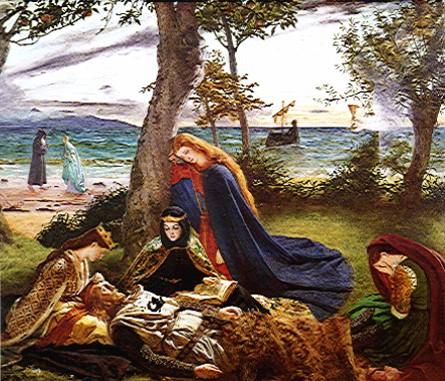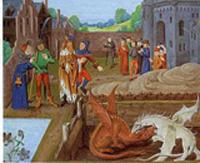

Explorations in Arthurian History
A Literature Review
Part 2: Geoffrey of Monmouth
Geoffrey of Monmouth, writing in the 12th
century, had quite a retinue of Welsh tales to work from, as
evidenced on the previous page. He made good use of these
legends and wholely invented many of his own in introducing
Arthur, King of the Britons; his adviser Merlin; Morgan Le
Fay; and a host of other conventions. Echoes of the Welsh tales can be found
from the beginning, with the inclusion of Bedivere
and Kay,
the former as Duke of Normandy and Arthur's right-hand man
and the latter as one of the king's brave knights.
Morgan
Le Fay is there, too, as the head
of a group of nine women guarding the Isle of
Avalon.
In Geoffrey, as in several subsequent sources, Morgan is
portrayed as a benign and, in some cases, helpful
enchantress who commands the Isle of Avalon as a
healer.

This final battle, of course, was
Camlann,
at which Modred
(Arthur's nephew according to Geoffrey) also died. Geoffrey
is quite clear in naming Modred as the instrument of
Arthur's death and vice versa. Arthur's magical sword, according to
Geoffrey, is Caliburn,
possibly based on the famous Irish sword Caladbolg (itself a
derivation of the Welsh Caledfwlch), and was forged on the
Isle of Avalon, which Geoffrey calls the "Isle of Apples."
Sadly, we are offered no description of this magical sword.
We are told, however, that Morgan Le Fay carries Arthur off
to the Isle of Avalon after the final battle. What happens to Arthur after that?
Geoffrey doesn't say, perpetuating the myth that the great
king didn't die. Geoffrey says Arthur was mortally wounded,
but Geoffrey doesn't say Arthur died. We are given many familiar themes and events,
though, beginning with Arthur's birth at Tintagel
Castle. Most of all in Geoffrey, we meet Merlin. In the
Historiae regum Brittoniae and in the later poem Vita
Merlini we see the full figure of Merlin. Interestingly, he is
portrayed as both the power behind Uther's and Arthur's throne and as
a wild man who runs mad into the woods. In both portrayals, he is a
prophet. The prophecy business begins with a bang with the
strange story of Vortigern's Tower in Dinas
Emrys: Wanting to build a fortress to withstand the
encroaching Saxons,
Vortigern
had come to his wit's end when his own advisors and seers could not
keep the foundation from falling. Desperate, he agreed to follow his
seer's advice to sprinkle the blood of a boy who had no father on the
ground. Merlin, born in Carmarthen
to the Princess of Demetia, who was (as legend and convenience would
have it) impregnated by an incubus, was the manin this case, the
boyfor the task. But rather than submit to another man's idea of
his fate, Merlin determined his own by going into a trance and
uttering what Geoffrey calls the Vitae Prophetiae, the
"Prophecies of Merlin"" His brother Uther assumes the kingship and
immediately gets himself into trouble. At a feast he spies
Ygerna,
wife of Gorlois
of Cornwall. Uther makes it very plain that he is attracted to her;
Gorlois makes it plain whose wife she is by leaving the feast and
heading home. When war is apparent between the two men, Gorlois
ensconces Ygerna in Tintagel Castle and walls himself up in Dimilioc
Castle. During the ensuing siege of Dimilioc, Uther is overcome with
desire for Ygerna and appeals for help to Merlin, who gives Uther
some "drugs" to take to change his appearance to that of Gorlois. It
is "Gorlois" who enters Tintagel Castle and lies with Ygerna,
begetting Arthur. Soon after, Uther meets the same fate as Ambrosius
and is buried in the same place. (It is worth noting here that
Geoffrey says Merlin uses "devices" to move the giant stones and
"drugs" to change Uther's appearance. Geoffrey does not say magic. He
also does not bring out the mystical element of Merlin's Prophecies.
To Geoffrey, these were events, not mysteries. Merlin is court advisor to Arthur as
well. Once Arthur is king, though, the focus shifts from
Merlin to Arthur. Geoffrey mentions Lot
as well, naming him Loth of Lodonesia and later Lothian, and
making him the parents (by his wife Anna, Arthur sister) of
Gawain
and Modred. The Historiae regum Brittoniae is
a feast for the fan of wild and tall tales but no picnic for
the historian. Geoffrey traces the Britons back to
Brutus,
a descendant of Aeneas of Troy. Brutus, we are told, founded
a kingdom at Troia Nova after driving the giants who
inhabited Albion into the hills, then named the island after
himself. Even more fanciful is that story of how Britain was
never conquered by the Romans. Still, the Historiae regum
Brittoniae is an entertaining read. It appears that Geoffrey spun out of
whole cloth many of the adventures and utterances of his
characters. In this, he was not alone. But he was alone in
describing many of what we now call Arthurian conventions.
He is the first to mention Caliburn, Avalon, and the story
of Arthur's birth at Tintagel . As has been shown, he
borrowed from Celtic tradition for other elements of his
story. And his story it is. For history, we must turn
elsewhere. Click here
to continue. See also The
Importance of Geography: Carmarthen

This title carried over when Ambrosius
became king. When the will of the people is faltering, Merlin tells
Ambrosius he needs the Giants' Dance, tall heavy stones in Ireland.
Leading the attack on Ireland is none other than Uther Pendragon,
Ambrosius's brother. The Irish prove no match for the Britons, and
the invaders focus on the stones. Having tried all manner of physical
labor, they turn to Merlin, who uses certain "devices" to make the
stones ready to move. The stones are transported back to Britain and
installed on the Salisbury Plain. Ambrosius returns to fighting
Saxons and is poisoned soon after.



Explorations in Arthurian History and Legends
Main
Page
Other
© 2000-2009 David White